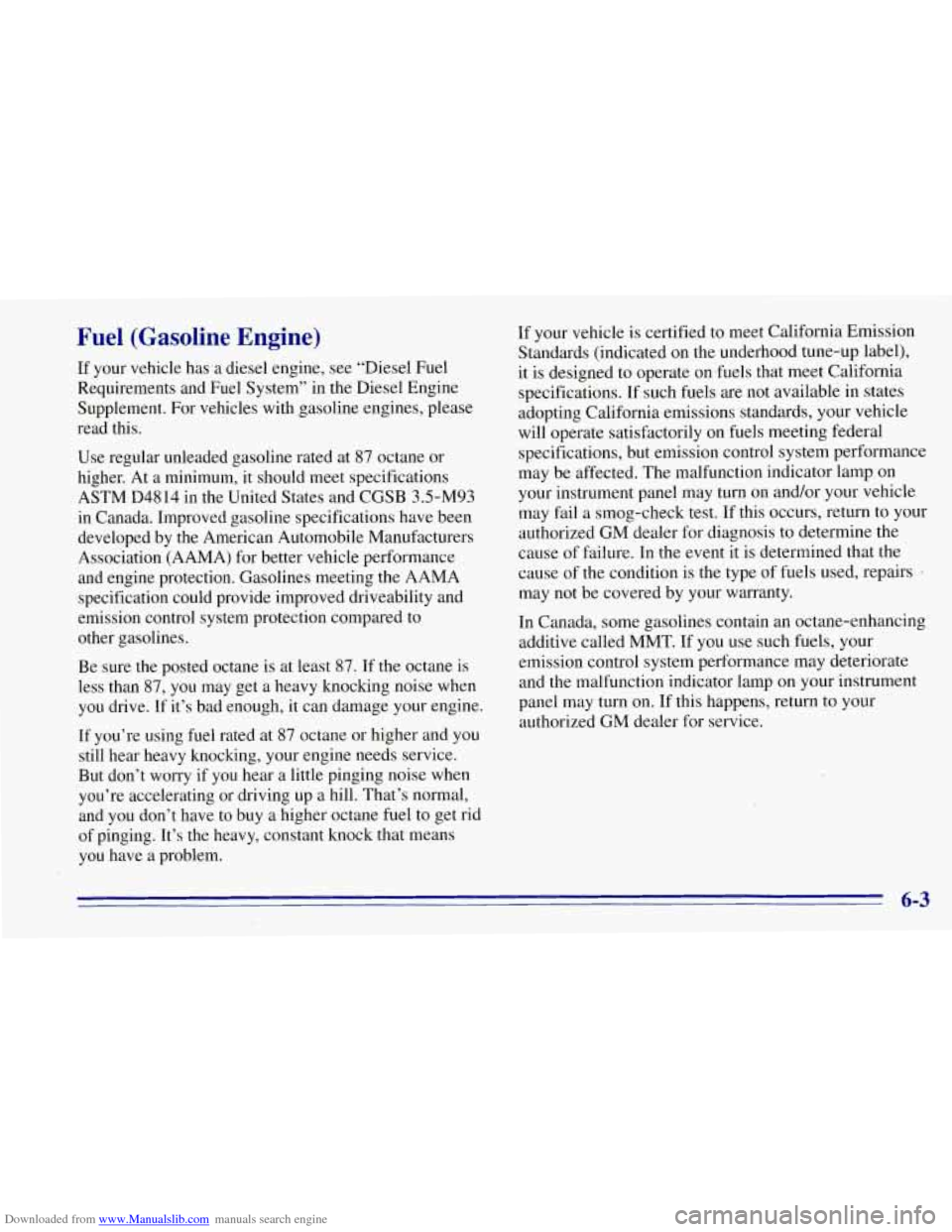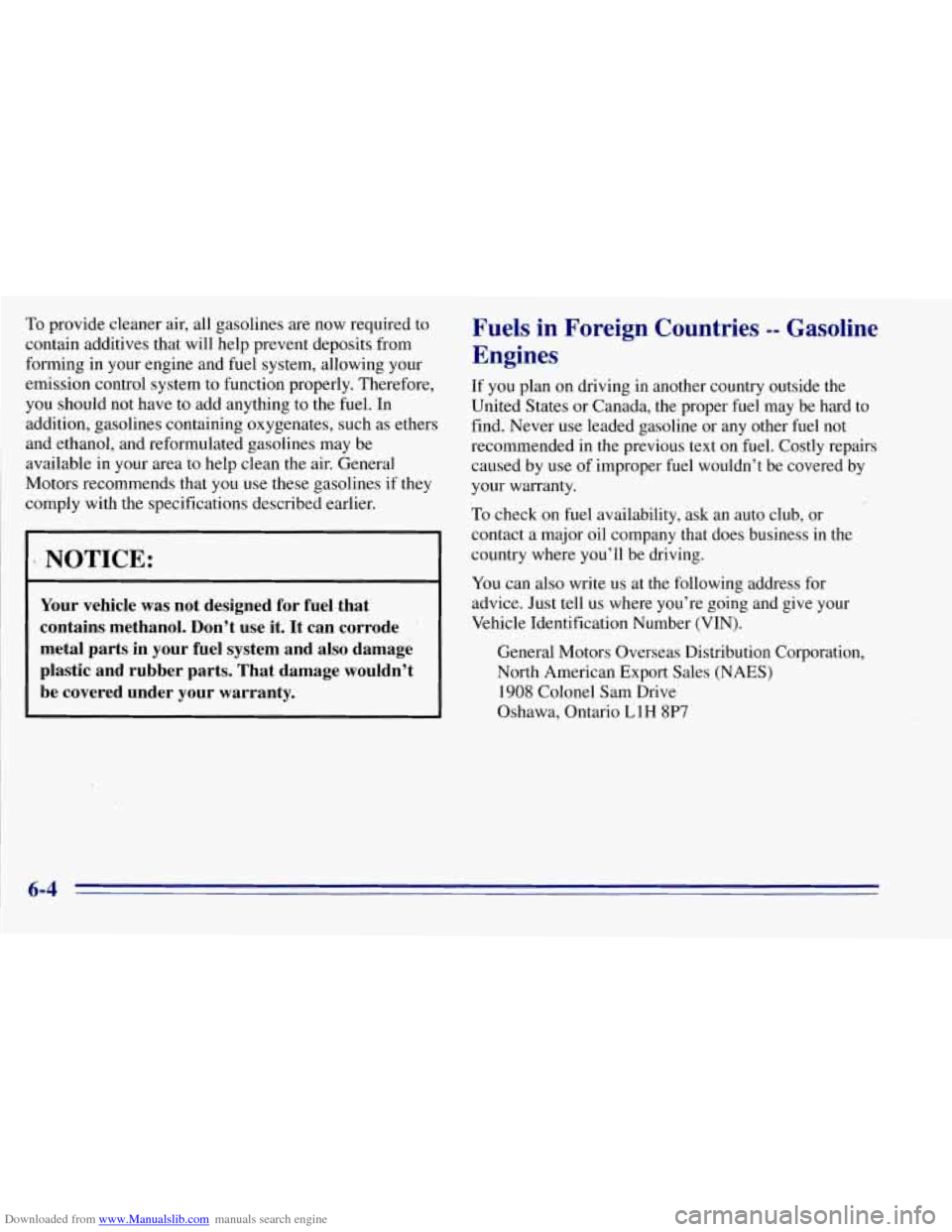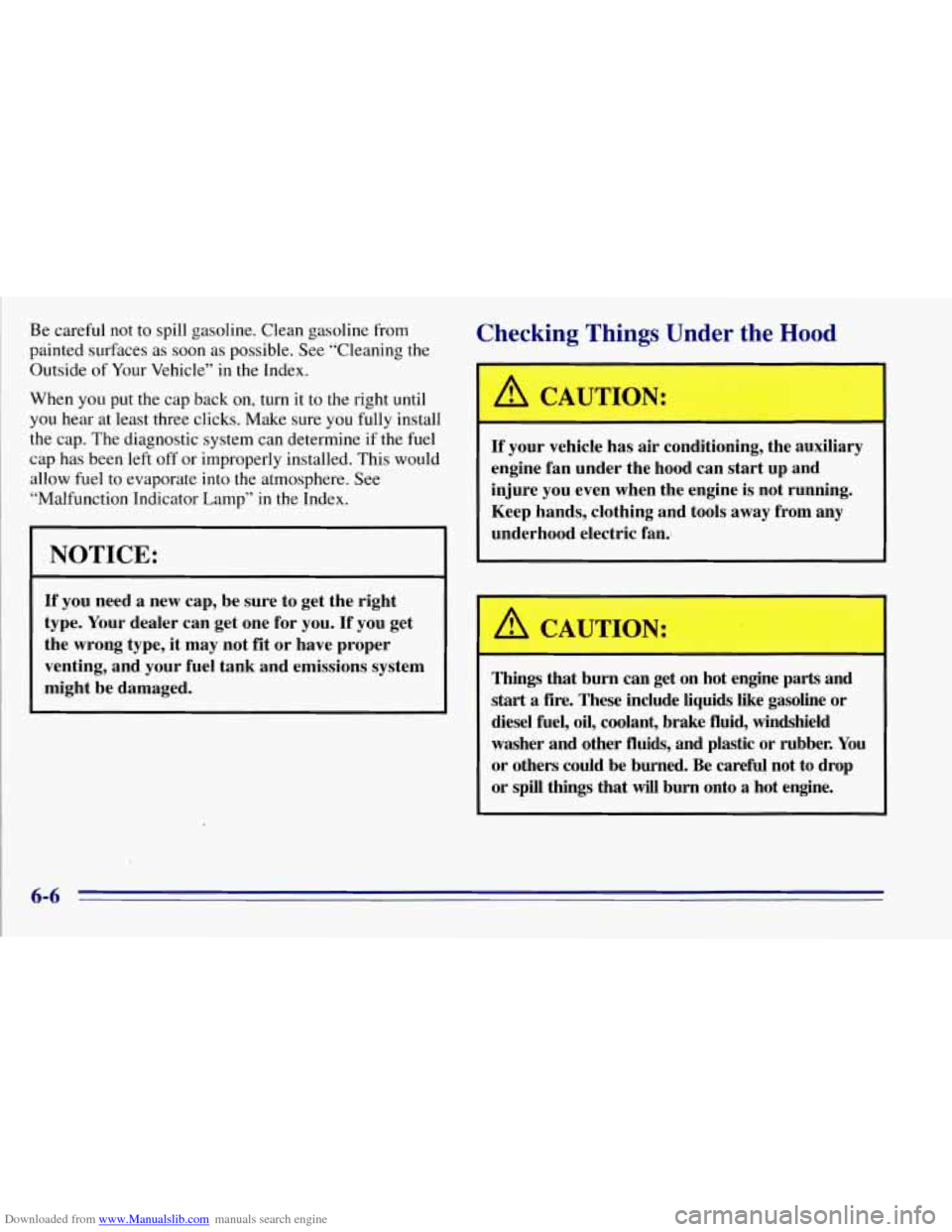Page 212 of 403

Downloaded from www.Manualslib.com manuals search engine When You Are Ready to Leave After
Parking on a Hill
1. Apply your regular brakes and hold the pedal down
while you:
0 Start your engine;
Shift into a gear; and
Release the parking brake.
2. Let ,up on the brake pedal.
3. Drive slowly until the trailer is clear of the chocks.
4. Stop and have someone pick up and store the chocks.
Maintenance When Trailer Towing
Your vehicle will need service more often when you’re
pulling a trailer. See the Maintenance Schedule for more
on this. Things that are especially important in trailer
operation are automatic transmission fluid (don’t overfill), engine oil, axle lubricant, belt, cooling system
and brake adjustment. Each
of these is covered in this
manual, and the Index will help you find them qoickly.
If you’re trailering, it’s a good idea to review these
sections before you start your trip.
Check periodically to see that all hitch nuts and bolts
are tight.
Trailer Wiring Harness
A seven-wire harness is stored under the rear of your
vehicle, between the frame rails. An electrical connector
will need to be added at the trailer end
of the harness, by
a qualified electrical technician. For additional trailer
wiring and towing information, please consult your
dealer. Securely attach the harness to the trailer, then
tape or strap it to your vehicle’s frame rail. Be
sure you
leave it loose enough so the wiring won’t bind or break
when turning with the trailer, but not
so loose that it
drags on the ground. Store’ the harness in its original
position. Wrap the harness together and tie it neatly
so it
won’t be damaged.
If you tow a trailer, your Center
High-Mounted Stoplamp (CHMSL) may not be
properly visible from behind.
You should select a trailer
with a CHMSL on
it or, if one is not available, have one
installed. See your GM dealer about how to connect
your vehicle’s wiring to a trailer CHMSL.
4-53
Page 219 of 403
Downloaded from www.Manualslib.com manuals search engine 4. Check that the jumper cables don’t have loose or
missing insulation.
If they do, you could get a shock.
The vehicles could be damaged, too.
Before you connect
the cables, here are some basic
things you should know. Positive (+) will go to
positive
(+) and negative (-) will go to negative (-)
or a metal engine part. Don’t connect positive (+) to
negative
(-) or you’ll get a short that would damage
the battery and maybe other parts, too.
I A CAUTION:
Fans or other moving engine parts can injure you
badly. Keep your hands away from moving parts
once the engines are running.
5. Connect the red positive (+) cable to the positive (+)
terminal of the vehicle with the dead battery. Use a
remote positive
(+) terminal if the vehicle has one.
5-4
Page 254 of 403
Downloaded from www.Manualslib.com manuals search engine Section 6 Service and Appearance Care
Here you will find information about the care of your
vehicle. This section begins with service and fuel
information, and then it shows how to check important
fluid and lubricant levels. There is also technical
information about your vehicle, and a part devoted
to its
appearance care.
Service
Your GM dealer knows your vehicle best and wants you
to be happy with it. We hope you’ll go to your dealer for
all your service needs. You’ll get genuine GM parts and
GM-trained and supported service people. We
hope you’ll want
to keep your GM vehicle all GM.
Genuine
GM parts have one of these marks:
n
Delco
6-1
Page 256 of 403

Downloaded from www.Manualslib.com manuals search engine Fuel (Gasoline Engine)
If your vehicle has a diesel engine, see “Diesel Fuel
Requirements and Fuel System”
in the Diesel Engine
Supplement. For vehicles with gasoline engines, please
read this.
Use regular unleaded gasoline rated at 87 octane or
higher. At a minimum, it should meet specifications
ASTM D4814 in the United States and CGSB 3.5-M93
in Canada. Improved gasoline specifications have been
developed by the American Automobile Manufacturers
Association (AAMA) for better vehicle performance
and engine protection. Gasolines meeting the AAMA
specification could provide improved driveability and
emission control system protection compared to
other gasolines.
Be sure the posted octane is at least 87. If the octane is
less than 87, you may get a heavy knocking noise when
you drive. If it’s bad enough, it can damage your engine.
If you’re using fuel rated at 87 octane or higher and
you
still hear heavy knocking, your engine needs service.
But don’t worry if you hear a little pinging noise when
you’re accelerating or driving up a hill. That’s normal,
and you don’t have to buy a higher octane fuel to get rid
of pinging. It’s the heavy, constant knock that means
you have a problem. If
your vehicle is certified to meet California Emission
Standards (indicated on the underhood tune-up label),
it is designed to operate on,fuels that meet California
specifications. If such fuels are not available in states
adopting California emissions standards, your vehicle
will operate satisfactorily on fuels meeting federal
specifications, but emission control system performance
may be affected. The malfunction indicator lamp on
your instrument panel may turn on and/or your vehicle
may fail a smog-check test. If this occurs, return to your
authorized GM dealer for diagnosis
to determine the
cause of failure. In
the event it is determined that the
cause of the condition is the type
of fuels used, repairs a
may not be covered by your warranty.
In Canada, some gasolines contain an octane-enhancing
additive called MMT. If you use such fuels, your
emission control system performance may deteriorate
and the malfunction indicator lamp on your instrument
panel may turn on.
If this happens, return to your
authorized GM dealer for service.
6-3
Page 257 of 403

Downloaded from www.Manualslib.com manuals search engine To provide cleaner air, all gasolines are now required to
contain additives that will help prevent deposits from
forming in your engine and fuel system, allowing your
emission control system to function properly. Therefore,
you should not have
to add anything to the fuel. In
addition, gasolines containing oxygenates, such
as ethers
and ethanol, and reformulated gasolines may
be
available in.your area to help clean the air. General
Motors recommends that you
use these gasolines if they
comply with the specifications described earlier.
* NOTICE:
I
Your vehicle was not designed for fuel that
contains methanol. Don’t use it. It can corrode
’
metal parts in your fuel system and also damage
plastic and rubber parts. That damage wouldn’t
be covered under your warranty.
Fuels in Foreign Countries -- Gasoline
Engines
If you plan on driving in another country outside the
United States or Canada, the.proper fuel may be hard to
find. Never use leaded gasoline or any other fuel not
recommended in the previous text on fuel. Costly repairs
caused
by use of improper fuel wouldn’t be covered by
your warranty.
To check
on fuel availability, ask an auto club, or
contact a major oil company that does business in the
country where you’ll be driving.
You can also write us at the following address for
advice. Just tell us where you’re going and give your
Vehicle Identification Number (VIN).
General Motors Overseas Distribution Corporation,
North American Export Sales (NAES)
1908 Colonel Sam Drive
Oshawa, Ontario
LlH 8P7
6-4
Page 259 of 403

Downloaded from www.Manualslib.com manuals search engine Be careful not to spill gasoline. Clean gasoline from
painted surfaces as soon as possible. See “Cleaning the
Outside of Your Vehicle” in
the Index.
When you put the cap back on, turn it to the right until
you hear at least three clicks. Make sure you fully install
the cap. The diagnostic system can determine if the fuel
cap
has been left off or improperly installed. This would
allow fuel to evaporate into the atmosphere. See
“Malfunction Indicator Lamp” in the Index.
NOTICE:
If you need a new cap, be sure to get the right
type. Your dealer can get one for you.
If you get
the wrong type, it may not
fit or have proper
venting, and your fuel tank and emissions system
might be damaged.
Checking Things Under the Hood
A CAUTION:
If your vehicle has air conditioning, the auxiliary
engine fan under the hood can start up and
injure you even when the engine is not running.
Keep hands, clothing and tools
away from any
underhood electric fan.,
A CAUTION: 1
Things that burn can get on hot engine parts and
start a fire. These include liquids like gasoline or
diesel fuel,
oil, coolant, brake fluid, windshield
washer and other fluids, and plastic or rubber.
You
or others could be burned. Be careful not to drop
or spill things that
will burn onto a hot engine.
6-6
Page 265 of 403
Downloaded from www.Manualslib.com manuals search engine Engine Oil (Gasoline Engine)
If vehicle has a diesel engine, see “Engine Oil
(Diesel Engine)” in the Diesel Engine Supplement.
It’s a good idea to check your engine oil every time you
get fuel. In order to get an accurate reading, the oil must
be warm and the vehicle must be on level ground.
The engine oil dipstick has a yellow ring handle and is
located
on the passenger side of the engine.
Turn off the engine and give the oil a few minutes to
drain back into the oil pan. If you don’t, the oil dipstick
might not show the actual level.
Checking Engine Oil
Pull out the dipstick and clean it with a paper towel or
cloth, then push it back
in all the way. Remove it again,
keeping the tip down, and check the level.
6-12
Page 269 of 403
Downloaded from www.Manualslib.com manuals search engine Air Cleaner
Your air cleaner is located between the battery and
coolant recovery tank. The
air cleaner assembly
has an indicator that lets
you know when the air
filter is dirty and needs
to be serviced.
The indicator is located in the air intake tube between
the air cleaner and the engine. See “Owner Checks and
Services” in the Index on when to check the indicator.
If
the area inside the clear section of the indicator is
green, no air filter service.is required. When the area
inside the indicator is orange and CHANGE AIR
FILTER appears, the filter should be replaced.